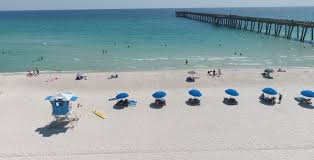Panama City Beach, located along the beautiful Gulf Coast of Florida, is famous for its sugar-white sands and crystal-clear waters. However, before heading out for a day of fun in the sun, it’s important to stay updated on the Panama City Beach water conditions. The water conditions can change daily due to various factors such as weather, tides, and currents. Knowing what to expect can help ensure a safe and enjoyable experience, whether you plan to swim, surf, or simply relax by the shore.
Factors That Affect Water Conditions
Weather and Tides
The weather plays a significant role in the water conditions at Panama City Beach. On sunny, calm days, the water is typically clear and smooth, making it perfect for swimming and snorkeling. However, when storms or strong winds roll in, the water can become choppy, leading to rougher waves and stronger currents.
Tidal changes also affect the water, as the tide can bring in more seaweed, jellyfish, or other marine life closer to the shore. High and low tides can change the depth of the water and impact visibility. During high tide, the water may rise, allowing for more swimming space, but it can also bring stronger rip currents.
Rip Currents
One of the biggest safety concerns at any beach is the presence of rip currents. Panama City Beach, like many coastal areas, experiences these strong currents that can quickly pull swimmers away from the shore. Rip currents are most common on windy days or when the ocean is rough, and they are often difficult to spot from the shore.
It’s crucial to pay attention to flag warnings posted along the beach, which indicate the level of risk for rip currents. A red flag means that the water is hazardous, while a double red flag indicates that the water is closed to the public. Always swim near lifeguards and be cautious if the water conditions appear challenging.
Daily Water Condition Reports
Flag Warning System
To help beachgoers stay safe, Panama City Beach uses a flag warning system that alerts visitors to the current water conditions. Each color represents different levels of danger in the water:
- Green Flag: Safe for swimming, with calm waters.
- Yellow Flag: Moderate surf and currents, swim with caution.
- Red Flag: High surf and strong currents, dangerous swimming conditions.
- Double Red Flag: Water closed to the public due to hazardous conditions.
- Purple Flag: Marine pests, such as jellyfish, are present.
Checking the flag status before heading to the beach is essential for ensuring a safe experience in the water.
Marine Life and Visibility
Another factor to consider when checking the water conditions at Panama City Beach is the presence of marine life. On some days, jellyfish or stingrays might be more prevalent, and the purple flag will be posted to warn swimmers. It’s also a good idea to wear water shoes or shuffle your feet when walking through the water to avoid stepping on a stingray.
The water clarity at Panama City Beach can also vary. On calm, sunny days, the water is often clear, offering excellent visibility for snorkeling or swimming. However, after heavy rains or storms, the water may become murkier due to stirred-up sand and debris.
Ideal Times for Water Activities
Best Times for Swimming
The best time to enjoy swimming at Panama City Beach is typically during the early morning or late afternoon, when the water is calmer, and there are fewer crowds. If you’re planning to swim, it’s always a good idea to check the daily water conditions and avoid going in the water when there are red or double red flags.
Surfing and Paddleboarding
For those who enjoy water sports like surfing or paddleboarding, slightly rougher water conditions with moderate waves may provide the ideal conditions for riding the waves. Checking local surf reports and water conditions before heading out is important for safety and for choosing the right day to enjoy these activities.
